Pro Breeze 12L Low Energy Dehumidifier review – the bestseller tried and tested
Our Pro Breeze 12L Low Energy Dehumidifier review puts this brand bestseller through its paces. But can its lower running costs make up for a few major flaws?
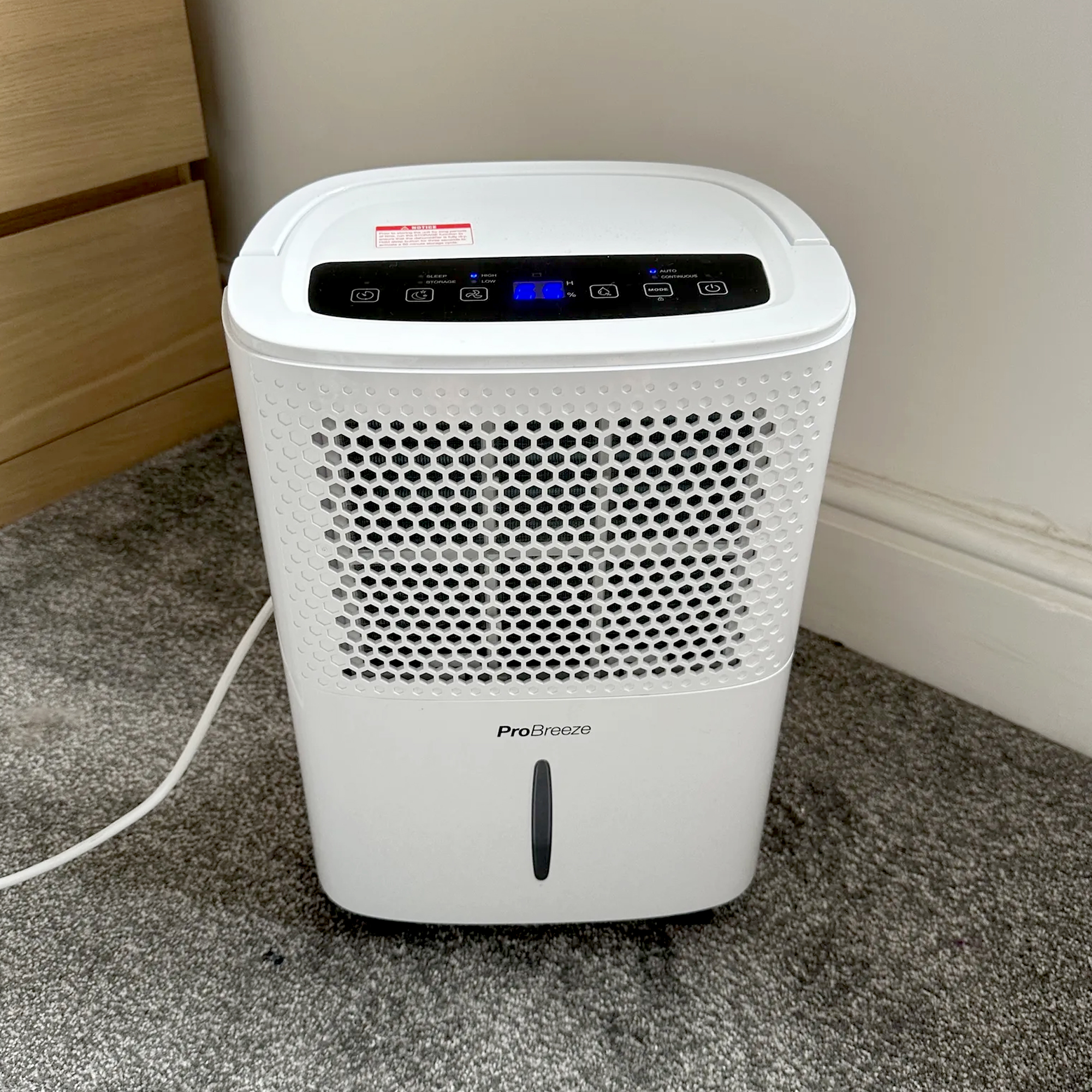
The Pro Breeze 12L Low Energy Dehumidifier has an affordable price point, powerful extraction rate, and relatively low energy usage. In our eyes, it's just let down by a small water tank, noisy operation, and a lack of Laundry mode.
-
+
Powerful extraction rate
-
+
Relatively low energy consumption
-
+
Compact
-
+
Automatic humidity sensor
-
+
Built-in 24-hour timer
-
-
Water tank is small and awkward to remove
-
-
Noisy
-
-
Didn't help to dry wet washing
-
-
Heavy
-
-
No WiFi connectivity
-
-
Compressor design not suitable for use below 5°C
Why you can trust Ideal Home

QUICK MENU
1. Specifications
2. Design
3. Ease of use
4. Performance
5. Energy use
6. Noise levels
7. Portability
8. Maintenance
9. How it rates online
10. Verdict
This Pro Breeze 12L Low Energy Dehumidifier review puts one of Pro Breeze's bestselling dehumidifiers through its paces. We aim to find out if the brand's lowest-priced compressor dehumidifier can live up to the hype and really offer both high performance and low energy use.
Dehumidifiers are fast becoming one of this year's must-have home appliances. As well as removing moisture from the air, which can help if your home suffers from dampness and mould, the best dehumidifiers can also help to reduce indoor laundry drying times, and improve indoor air quality.
Alongside Meaco, Pro Breeze is one of the biggest names in the dehumidifier market, usually delivering appliances that offer solid performance at a mid-range price point.
The Pro Breeze 12L Low Energy Dehumidifier is one of the brand's bestsellers, offering the ability to extract up to 12L of moisture per day from the air, a decent sized 1.8L water tank, a compact build, the option of continuous drainage, and – its main USP according to the brand – lower energy use than other compressor dehumidifiers in the Pro Breeze range.
I tested the Pro Breeze 12L Low Energy Dehumidifier in several rooms in my home; the kitchen to see how quickly it could extract steam and cooking fumes, my living room and bedroom to assess noise levels when I was trying to relax, watch TV, or sleep, and in my laundry drying area to see if it could help to dry wet washing indoors, faster.
Read on to see how the Pro Breeze 12L Low Energy Dehumidifier performed against the competition.
Pro Breeze 12L Low Energy Dehumidifier review
Specifications
- Type: Compressor
- Extraction rate: 12L
- Water tank capacity: 1.8L
- Max room size recommended: 15m²
- Noise level: 40dBA
- Power: 220W
- Dimensions: H44 x W30 x D22cm
- Weight: 9.5kg
- Portable?: Yes
- Automatic humidity sensor: Yes
- Continuous drain option: Yes
- Laundry mode: No
- WiFi connectivity: No
- Timer: Yes
- Operating temperature: 5°C - 32°C
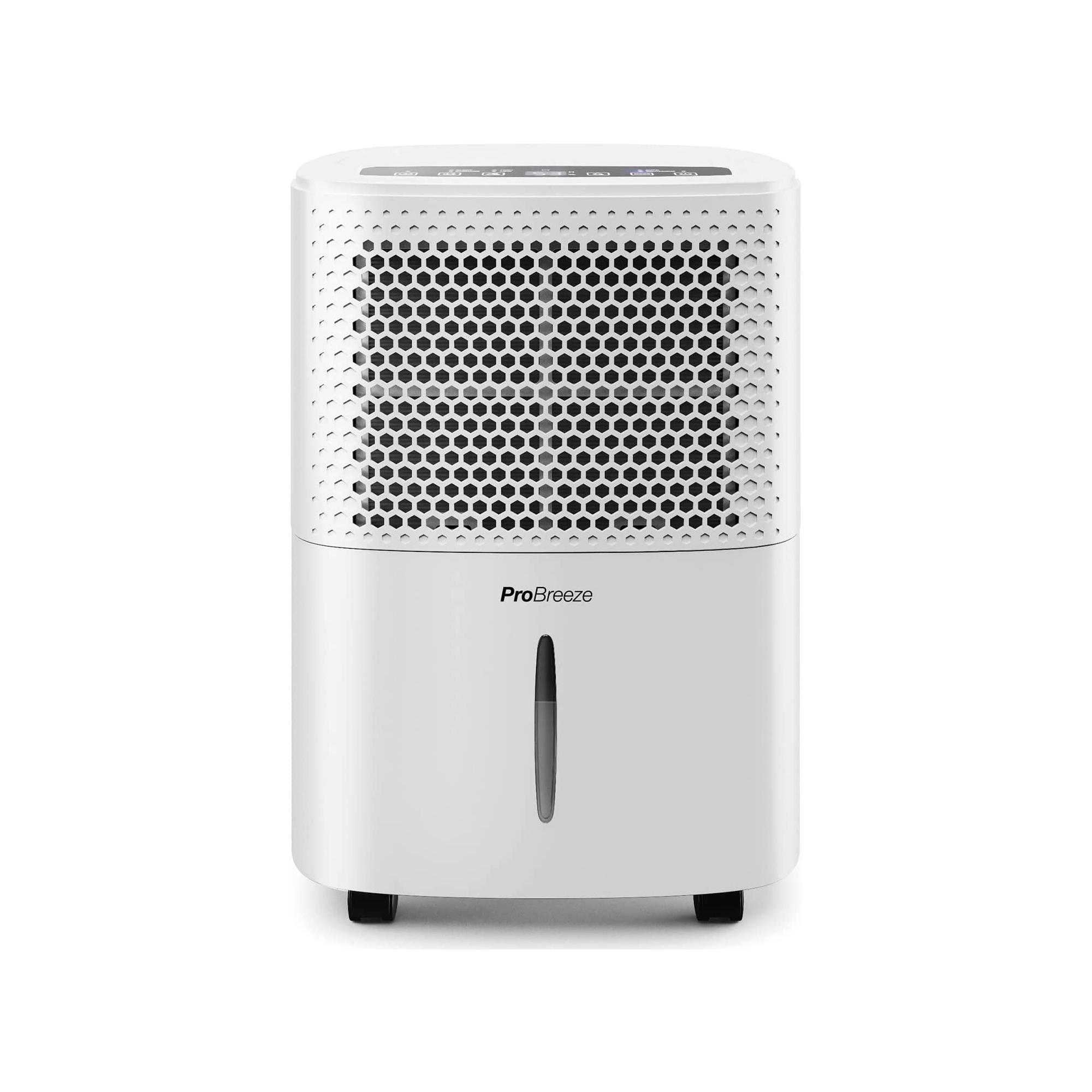
How I tested

I’m Rachael, a freelance reviewer who helps the Ideal Home team put all manner of products through their paces to find the top recommendations for our readers, whether that's the best patio cleaner for a spotless backyard, or the best mattress for a good night's sleep. I live in a Victorian terrace in Newport, South Wales, with my partner Chris and our two terriers, a Westie called Maggie and a Sealyham called Murray.
Unboxing
The Pro Breeze 12L Low Energy Dehumidifier isn’t that big, but it is heavy. The dehumidifier itself weighs 9.5kg and, as the delivery box has no handles or cut-outs, it was quite a challenge getting the packaged appliance through the front door and to a spot where I could unbox it.
The cardboard packaging is super thick, which is great as it’s sturdy enough to protect the dehumidifier in transit, but trying to fold it down and put it in the recycle box is a struggle! The dehumidifier also arrives sandwiched between two large pieces of polystyrene to stop it from moving around in transit, so there's a fair bit of excess packaging within the box. Of course, this is understandable, but because it can’t be recycled, the polystyrene took up a lot of room in our main bin.
The box also contains an instruction manual which gives a full rundown on how to use the dehumidifier, as well as warranty information. Plus, there's a hose pipe for the continuous drainage mode and a spare hose.
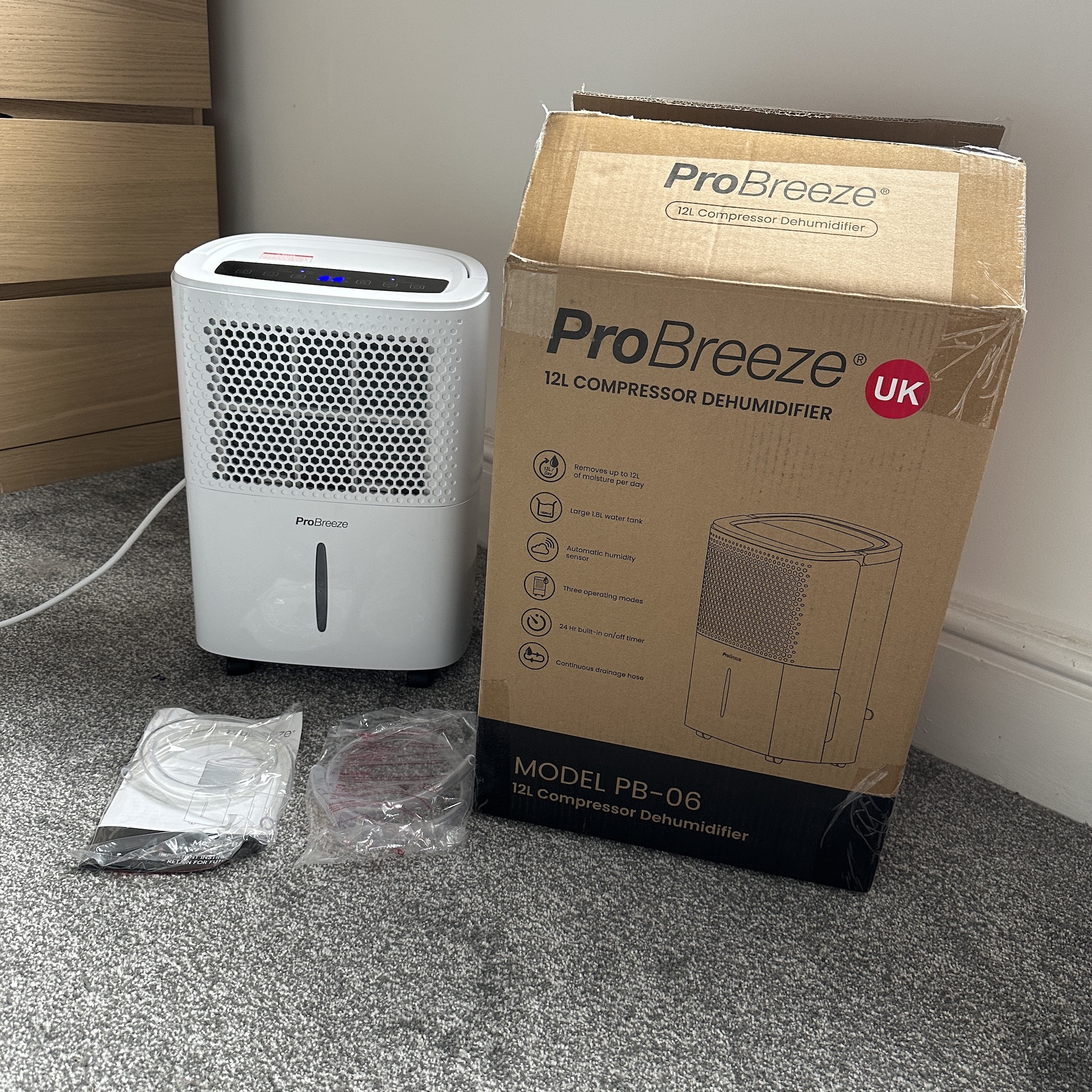
Assembly and set-up
There's no assembly required with this dehumidifier. However, as it's a compressor dehumidifier you do need to let it stand for at least six hours once it's been delivered to allow the refrigerant to settle before use.
The only thing that could need attaching is the hose pipe should you want to run the dehumidifier on a continuous drainage basis. If you do want to do that, simply take the hose that’s included with the dehumidifier and attach it to the outlet on the back. (Make sure that if you remove the hose the stopper goes back in securely otherwise you risk a leak the next time you use it).
The Pro Breeze 12L Low Energy Dehumidifier doesn't have Wi-Fi or App connectivity, so there's no set-up required. Once the refrigerant has settled you can just plug it in and turn it on.
Design
The Pro Breeze 12L Low Energy Dehumidifier is a pretty affordable compressor dehumidifier as these things go, which is reflected in its rather basic design.
However, its all-white casing means it’ll effortlessly fit in with most decors, and its honeycomb-style front grill adds a little style. It measures H44 x W30 x D22cm, so it’s also compact enough not to take up too much space.
The top of the unit is where all the controls are. This control panel is matt black, so the white controls stand out and are easy to see. Here you can find the power button and the timer button, which also has a timer indicator light.
There’s a sleep mode and storage cycle button, which also has an LED light which will alert you to which function you have switched on. Then there’s a fan button which again has a corresponding LED light so you can toggle between low and high. In the middle, you’ll find a LED display which will indicate the percentage of humidity that is currently being detected. You can also see what humidity is selected when you press the humidity button. Finally, there’s a mode button so you can flip between auto and continuous modes, this button also doubles up to apply the child lock.
At the top of the unit you’ll find an extendable handle for easy portability and there are castors on the bottom of the dehumidifier to wheel it around.

It's worth noting that the air intake is at the back of this dehumidifier, which means you can't position it flush against a wall as it needs room for the air to circulate. That said, you’d not be able to push it too far back anyway as there’s a cable tidy that extrudes from the back. Although this is super handy for making sure you don’t have to deal with any unsightly wires when it’s not in use.
Ease of use
As mentioned, the Pro Breeze 12L Low Energy Dehumidifier doesn't have Wi-Fi or App connectivity, so the dehumidifier is operated via the control panel on the top of the appliance.
I found the controls very simple to use, with the LED lights making it easy to see which functionality is currently selected.
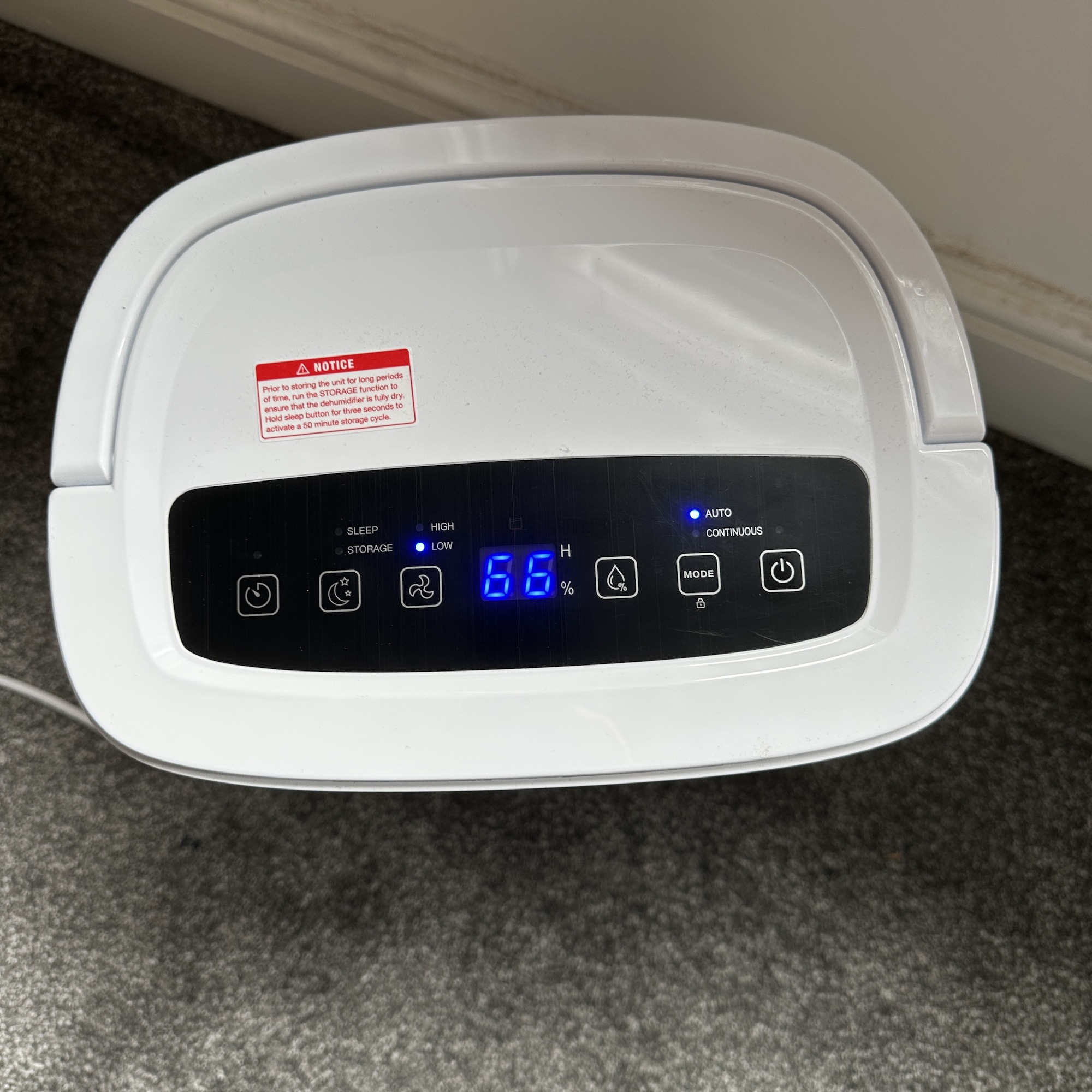
The only area I struggled was in emptying the water tank. This is positioned at the front of the dehumidifer, and – at least on the model I tested – it’s really stiff to pull out. I had to hook my fingers under the ridge and yank – a more difficult task than on most dehumidifiers I've tested.
Having to jerk the water tank pretty hard to remove it causes more problems once you realise the water tank doesn’t have a cover. That’s fine if the tank is half full, but when you’ve got a full tank of water, you to have to be very careful it doesn’t splash everywhere when pulling the tank out of the dehumidifer, and then again watch you don’t spill it on the way to emptying it.
Because the water tank only has a capacity of 1.8L, that also means clumsy water tank emptying is going to be a frequent task. For comparison, the 12L MeacoDry Arete One dehumidifier has a water tank capacity of 2.5L.
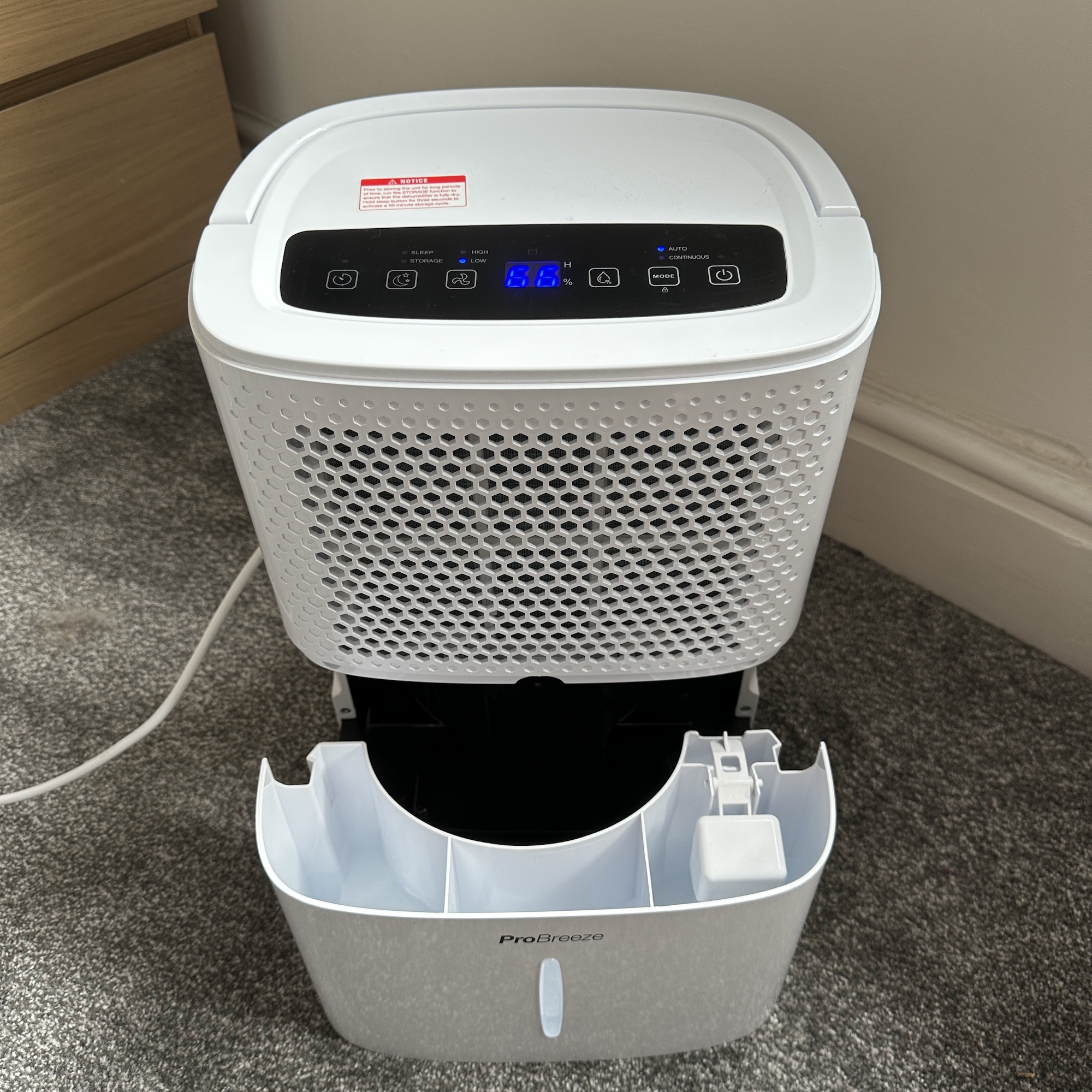
Performance
The Pro Breeze 12L Low Energy dehumidifier can extract up to 12 litres of excess moisture from the air per day, and the brand recommends it for use in areas up to 15m².
There are three operating modes to choose from – automatic, continuous, or sleep – and two fan speeds. Plus a storage mode and 24 hour timer.
Once I had it up and running, I found this dehumidifier was quick to extract moisture from the air, especially in areas of my home that I know are a little more damp than others. In fact, the 1.8L capacity water tank was soon full of condensed water that the machine had sucked from the air in my Victorian terrace.
However, although it's good to know it works, this is a bit of a downside of the dehumidifier's powerful extraction rate, as although the Pro Breeze 12L Low Energy dehumidifier features automatic shut off when the water tank is full, the fairly small tank capacity means you'll be emptying the tank frequently to keep up with th dehumidifier's extraction.
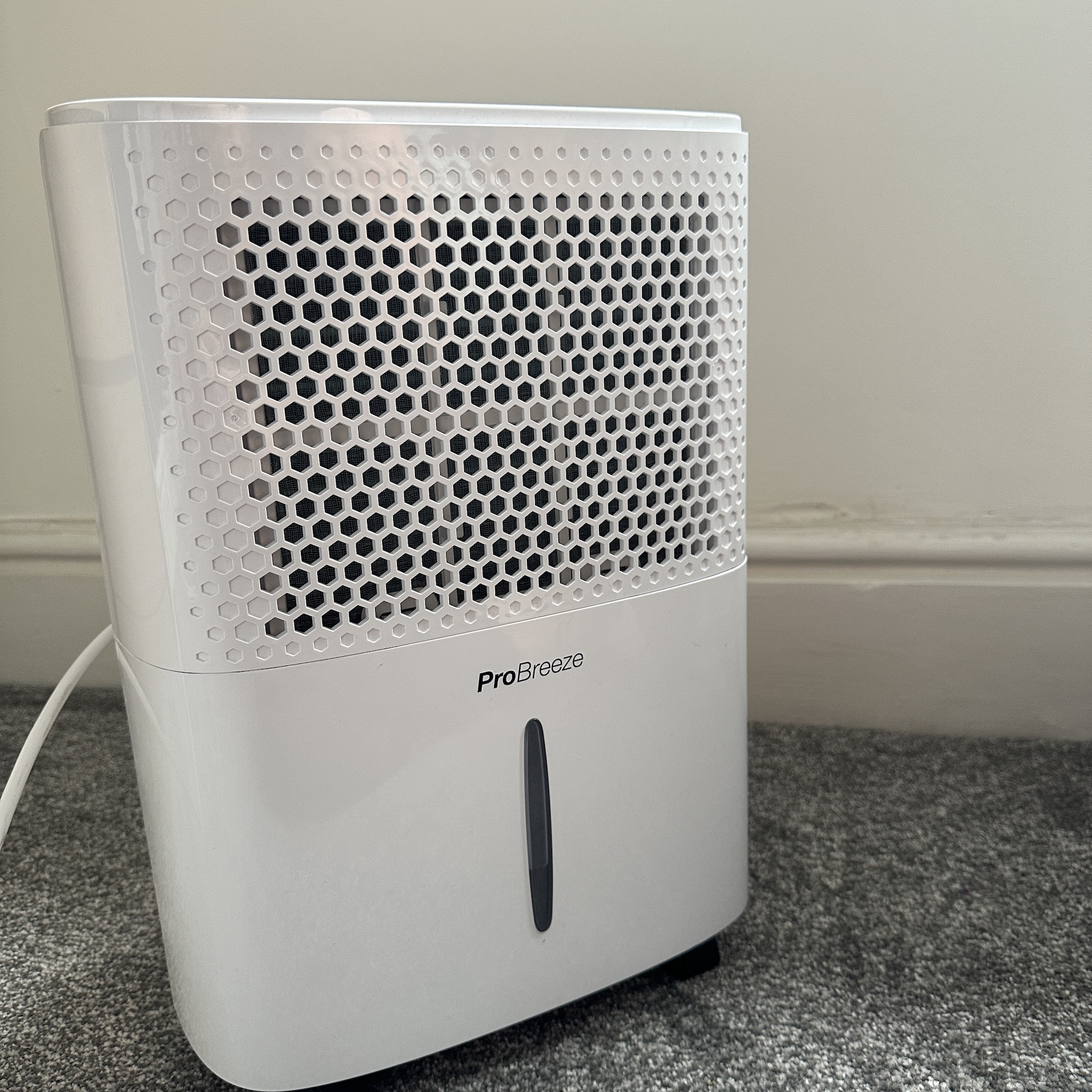
When operating the Pro Breeze 12L Low Energy Dehumidifier, you can either leave it running continuously until you switch it off, or make the most of the built-in Automatic Humidity Sensor. This allows you to set your desired room humidity between 30%-80%, and once this level is reached the unit will turn off to conserve energy.
In testing, I thought the humidity sensors were really good. They kicked in every time the humidity went over the 60% range I selected. You can adjust your target humidity in increments of 5%, and the digital LED display is clear and easy to understand. In automatic mode the dehumidifier will also control the fan speed, kicking it up to high if it has a lot of humidity to extract and down to low if it's maintaining the humidity level.
The dehumidifier promptly stopped once the target humidity was met which means I used less energy, making it ideal for anyone worrying about electricity bills.
I was less impressed by the unit's sleep function, as it meant I couldn’t adjust the fan speed, and although this dehumidifier is noisy in all modes (more on that below), it is even more so on a high fan setting.
Despite Pro Breeze's website claims, I also didn’t find the Pro Breeze 12L Low Energy dehumidifier that great for drying clothes. Perhaps I didn’t have it on the right setting, but after 24 hours the wet washing I had hanging in my laundry room was still damp even though I had the dehumidifier running continuously, and there’s no specific laundry mode on this model which is a shame.
I think the Pro Breeze 12L Low Energy dehumidifier is probably better suited to those who have damp walls or window condensation and are looking for a dehumidifier that can manage the situation, rather than intensive moisture extraction. If you're looking for the best dehumidiifer for drying clothes then, in my testing experience, that has to be the Pro Breeze 20L Premium Dehumidifier with Special Laundry Mode. You can read more in my Pro Breeze 20L Premium Dehumidifier with Special Laundry Mode review.
I also gave the continuous drainage option on the Pro Breeze 12L Low Energy Dehumidifier a go. Plumbing the hose into the machine was super easy, and I did find this worked really well. However, in continuous mode – as you might expect – the usual auto shut-off function that kicks in when the water tank gets full doesn’t work. So if you’re using a bucket to drain the water into, rather than a sink or drain, just be aware you’ll need to keep a close eye on those water levels because this machine does suck up moisture quickly thanks to its powerful fan action.
Energy use
Of course, with the cost of living and climate crisis, it's important to take into account the energy usage of any home appliance, and you'll likely be wondering how much a dehumidifier costs to run.
Running costs vary depending on the size, make and model of dehumidifier you opt for. However, the Pro Breeze 12L Low Energy dehumidifier is specifically marketed as a low energy use dehumidifier, so energy costs should be low.
In practice, the Pro Breeze 12L Low Energy dehumidifier uses an average of 220W to operate. This is far less than the 440W the Pro Breeze 20L Premium Dehumidifier with Special Laundry Mode uses, but still far higher than the comparable MeacoDry Arete One 12L Dehumidifier which uses on average just 151W.
For comparison, at current energy costs, the 12L MeacoDry Arete One Dehumidifier uses around 4p of electricity per hour, and the Pro Breeze 12L Low Energy dehumidifier uses roughly 6p per hour. Not a massive difference in running costs, but worth bearing in mind before you snap up this dehumidifier purely based on its low energy claims.
Noise levels
In my opinion noise levels are where the Pro Breeze 12L Low Energy dehumidifier is really let down. Its noise rating is 40dB, but as I've discovered whilst testing a number of small appliances, it's the quailty of the noise as well as the volume that determines how intrusive it will be.
The Pro Breeze 12L Low Energy dehumidifier's 40dB volume is already higher than the MeacoDry Arete One 12L Dehumidifier 35-38dB, but its the type of noise the Pro Breeze model creates that makes it the far noisier investment.
Once switched on, no matter which mode or fan setting you opt for, it sounds like a generator buzzing (noisily) in the background. So, as far as my test were concerned at any rate, this isn’t a dehumidifier you'll want to run when you’re trying to work, watch TV or sleep. I could even hear it over the sound of my not-at-all-quiet dishwasher in one instance.
In my opinion it would have benefitted from an air filter at the back of the unit – another thing the Pro Breeze 12L Low Energy dehumidifier lacks in comparison to the MeacoDry Arete One 12L dehumidifier – without one you can see the fan whizzing round through the back grill of the dehumidifier, which doesn't do much to muffle any noise.
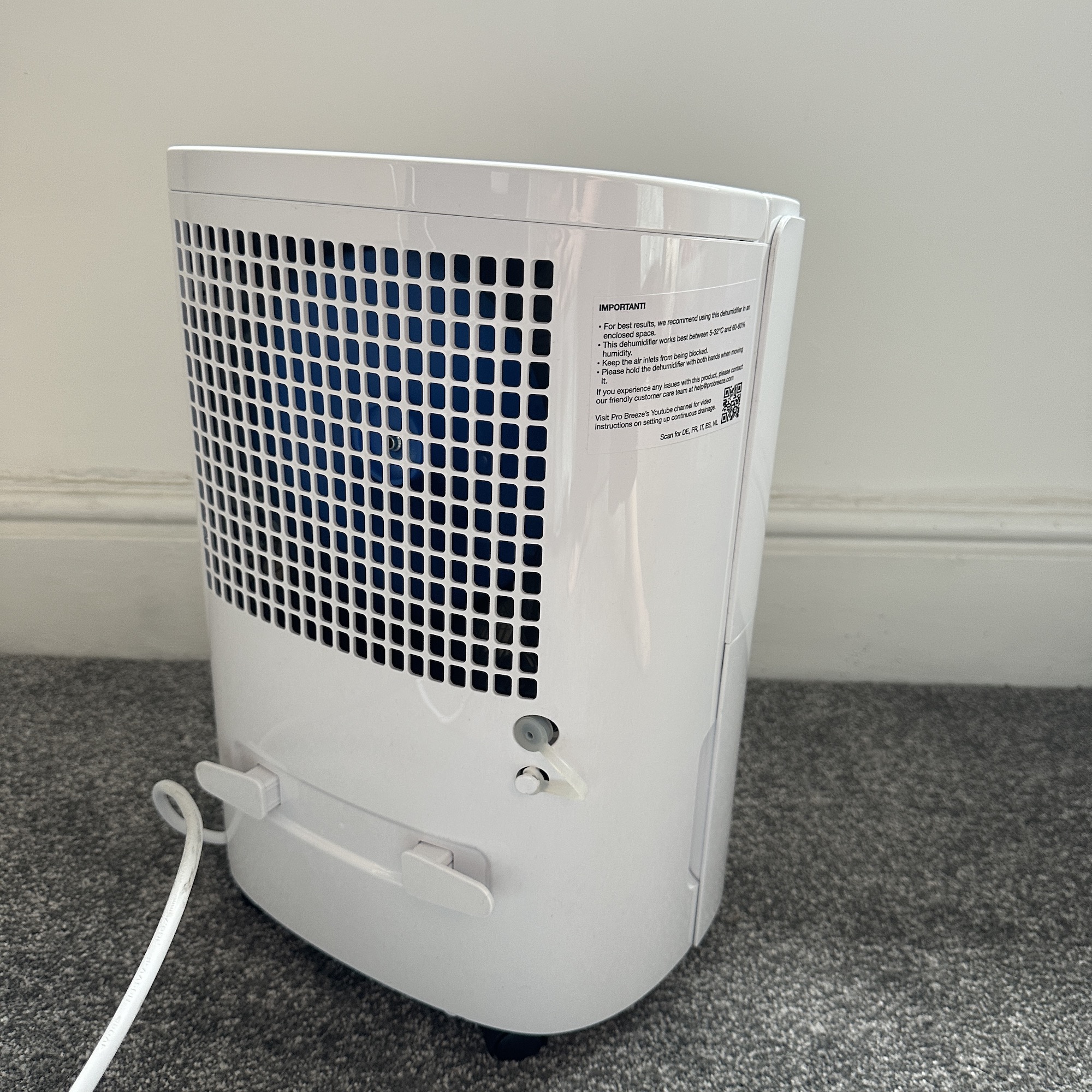
Portability
Whilst this dehumidifier is compact in stature, it is heavy, weighing in at 9.5kg. Pro Breeze have tried to make it as portable as possible by adding a fold-down handle to the top and built-in castor wheels to the base.
However, considering its weight, I found the handle felt quite flimsy. I didn't entirely trust it would support the weight of the dehumidifier if carried by this alone.
The handle also flops back and forth and doesn't stay in an upright position, and whilst this didn't really cause me any issues, I could imagine it might be a pain if you were trying to carry the dehumidifier up the stairs or move it to another room and had to stop for a breather on your way.
The castors are built into the bottom of the unit so you can wheel it from room to room. These work great on hard floor but on a carpeted area it just wouldn’t budge.
So, whilst this dehumidifier is portable, you’re probably not going to want to move it around too much.
It’s also worth making sure that the tank is empty of water when you move it, as the lack of water tank cover will mean water is likely to splash around.
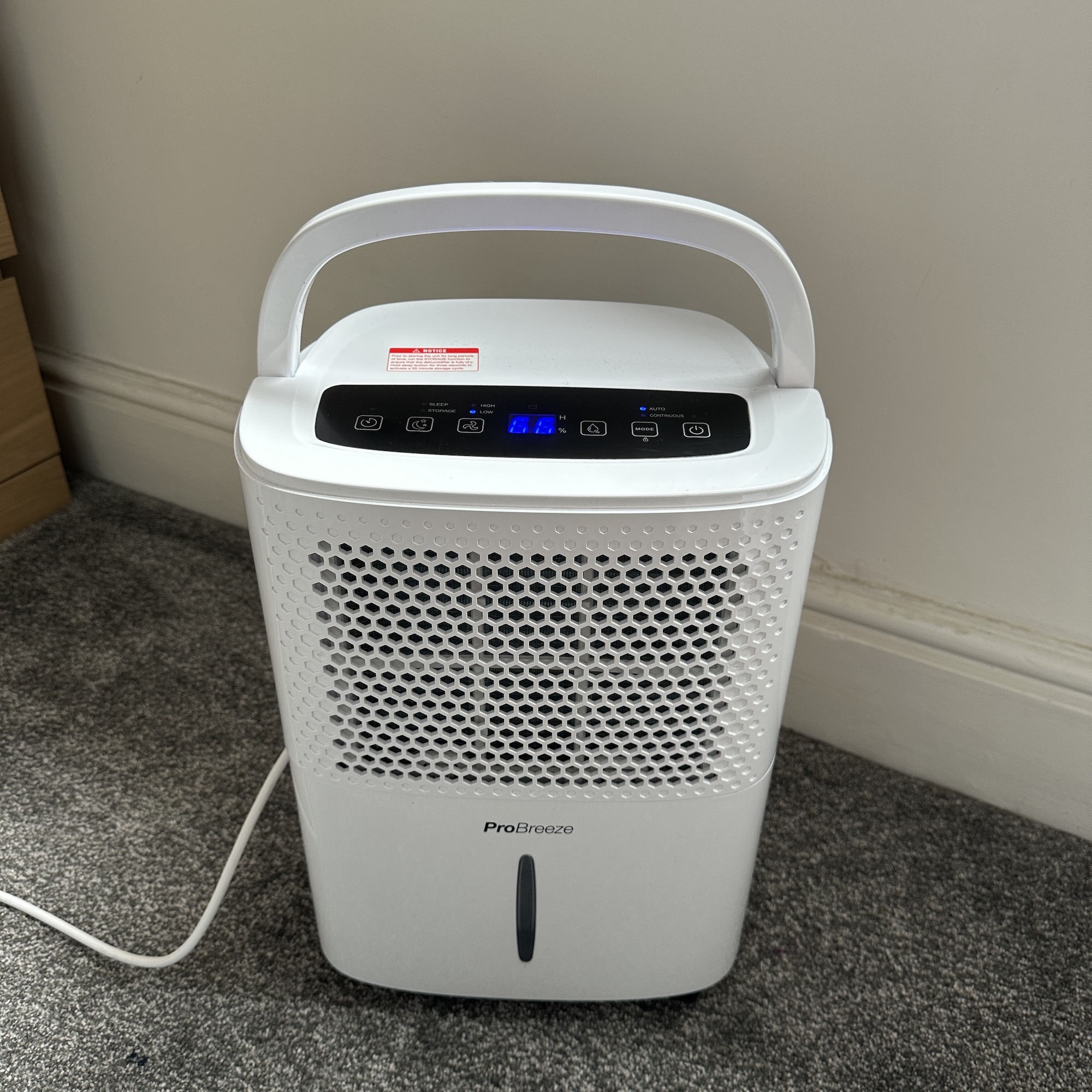
Maintenance
As previously mentioned, emptying the water tank on the Pro Breeze 12L Low Energy Dehumidifier was neither easy nor a pleasant experience.
For some reason, Pro Breeze has neglected to put a cover on the top of the water tank, so when you pull it out to empty it (which is in itself awkward as there's no proper handle to remove it) the water sloshes around everywhere, potentially drenching your flooring.
The lack of any real pouring spout also means you really need to empty the tank into a large area, like a bath or the shower, to avoid spillage. I usually like to use the condensed dehumidifier water to water my indoor plants, but I found it too tricky to decant into a jug from this tank, so ended up throwing the water outside onto the garden.
Once you've removed it, it's important to regularly clean out the water tank to ensure that you don’t have a build-up of deposits. It can be washed in warm soapy water, just be sure to fully dry the water tank before replacing it in the machine, especially if you’re not going to use the dehumidifier for a while so that you don’t get any mould.
To help with this, the Pro Breeze 12L Low Energy Dehumidifier benefits from 'storage' mode. To activate, just press and hold the sleep mode button for three seconds. This will cause the dehumidifier to stop collecting water and run the fan on high speed for around 30 minutes, followed by another 20 minutes at low speed. This process dries the dehumidifier out so you can safely store it away.
Beyond that, maintenance-wise, you just need to keep the dehumidifier clean. Unplug the machine on a regular basis and just run over it with a damp cloth, don’t use abrasive cleaners that could damage the plastic.
Using a vacuum on the grill areas will also help to remove any dust and debris that’s got stuck inside. There is a removable dust filter at the front of the dehumidifier that can also be cleaned. A clean dehumidifier will work a lot more efficiently.

How it rates online
Overall, reviews of the Pro Breeze 12L Low Energy Dehumidifier online are pretty positive.
A lot of user reviews appreciate that, compared to many dehumidifiers, it is relatively cheap to run. And like me, users tend to find it does a great job at collecting a large amount of water in a short period of time. Owners were also really impressed by the compact size of the unit considering how powerful it is.
There are a couple of complaints, similar to mine, regarding its noise levels, stating that it’s not quiet even when on its lowest fan setting, and certainly not in night mode, or on a high fan speed setting.
Like me, some users also found the water tank capcacity too small considering the extraction rate that can be achieved per day, which left them having to empty it frequently.
Verdict
If your home suffers from damp, mould or condensation, then the Pro Breeze 12L Low Energy Dehumidifier has the ability to solve the problem quickly. It's powerful, and works fast to remove any moisture from the air. Its price point is also reasonable, with a current RRP of £139.99.
And although it can't quite compete with the MeacoDry Arete One 12L Dehumidifier on energy efficiency, it is still relatively energy efficient, especially compared to other compressor dehumidifiers in the Pro Breeze range.
That said, it does have some downsides. In my opinion, its 1.8L water tank is too small for its 12L extraction rate, leading to frequent emptying. And emptying the water tank is a hassle, with the tank tricky to remove and the lack of cover making water spillages likely. Although, it does have a continuous drainage option, which if you have the means to drain it, could solve that problem.
Despite its compact size, it's also heavy. And whilst it does have a carry handle and castors, you’re not going to want to move it around too much.
I also found it very noisy. Even when the fan was set to low I could hear it over the TV, and I definitely couldn't have slept with it running. I also didn’t find it a great help with drying clothes, whilst it did take some of the moisture out of the garments, it didn’t leave them airing-cupboard dry like the best dehumidifiers I've tested.
However, the Pro Breeze 12L Low Energy Dehumidifier is also less expensive than many comparable models. At an RRP of £139.99, that's a fair bit cheaper than the £199.99 RRP of the Pro Breeze 20L Premium Dehumidifier with Special Laundry Mode (which we feel is the best dehumidifier for clothes drying), and slightly less expensive than the MeacoDry Arete One Dehumidifier which we still think is the best dehumidifier overall. For comparison the Meaco option with the same extraction rate, the MeacoDry Arete One 12L Dehumidifier currently retails for £179.99.
However, if you opt for the MeacoDry Arete One 12L Dehumidifier you also get a built-in air purifier, larger 2.5L water tank, better laundry drying performance, quieter operation, and better energy efficiency.
Overall, the Pro Breeze 12L Low Energy Dehumidifier performs well and does deliver on its promise of low energy usage compared to many other compressor dehumidifiers. If this dehumidifier is at your very maximum budget, then it will do the job – as long as you can put up with its noisy operation and frequent emptying of the water tank. If your budget can stretch a little bit further, then personally I'd opt for the best-in-class MeacoDry Arete One Dehumidifier instead.
Get the Ideal Home Newsletter
Sign up to our newsletter for style and decor inspiration, house makeovers, project advice and more.
-
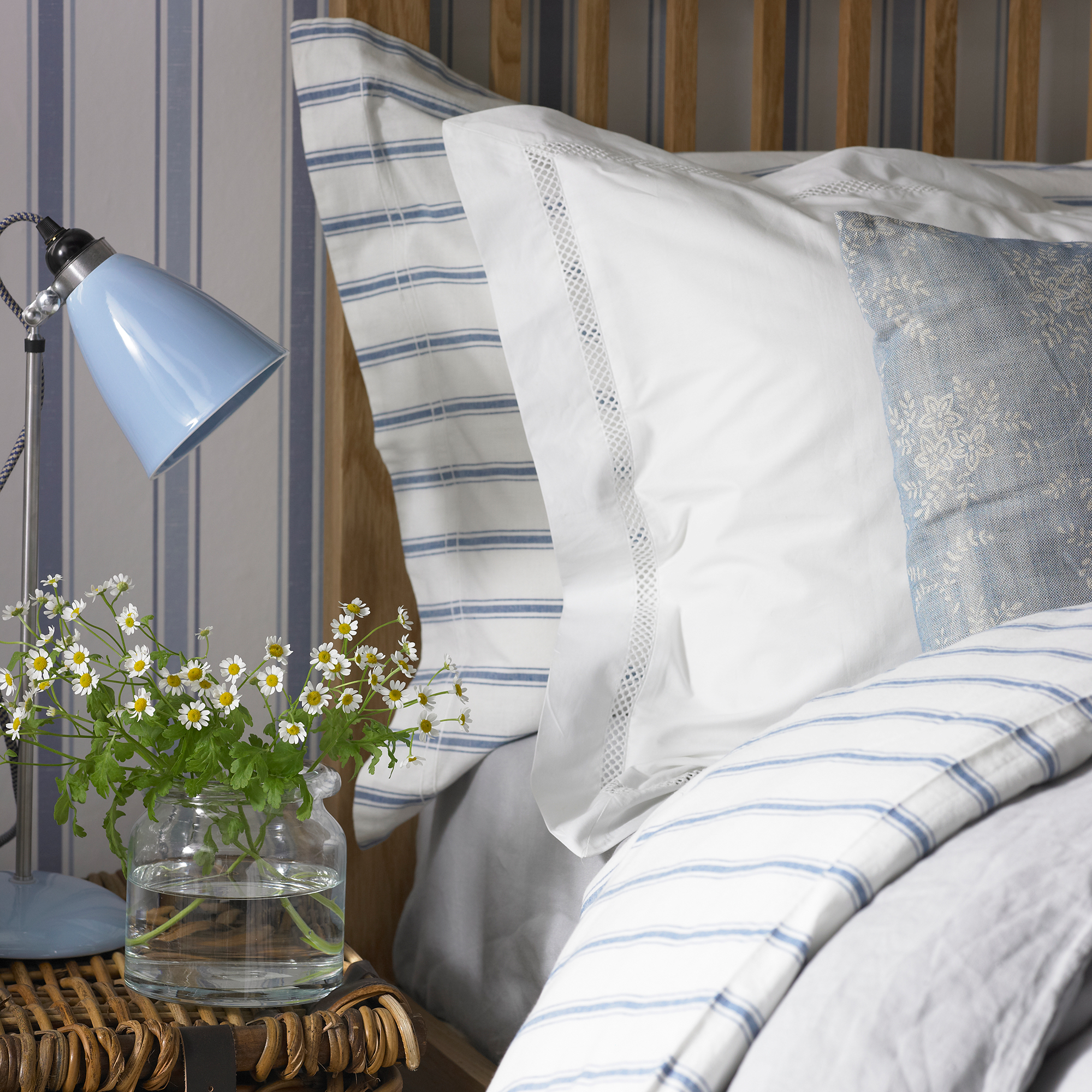 Weighing up M&S versus John Lewis bedding? As a Sleep Editor, I've tested both brands, and this is my go-to store
Weighing up M&S versus John Lewis bedding? As a Sleep Editor, I've tested both brands, and this is my go-to storeThe battle of the bedding is on
By Amy Lockwood
-
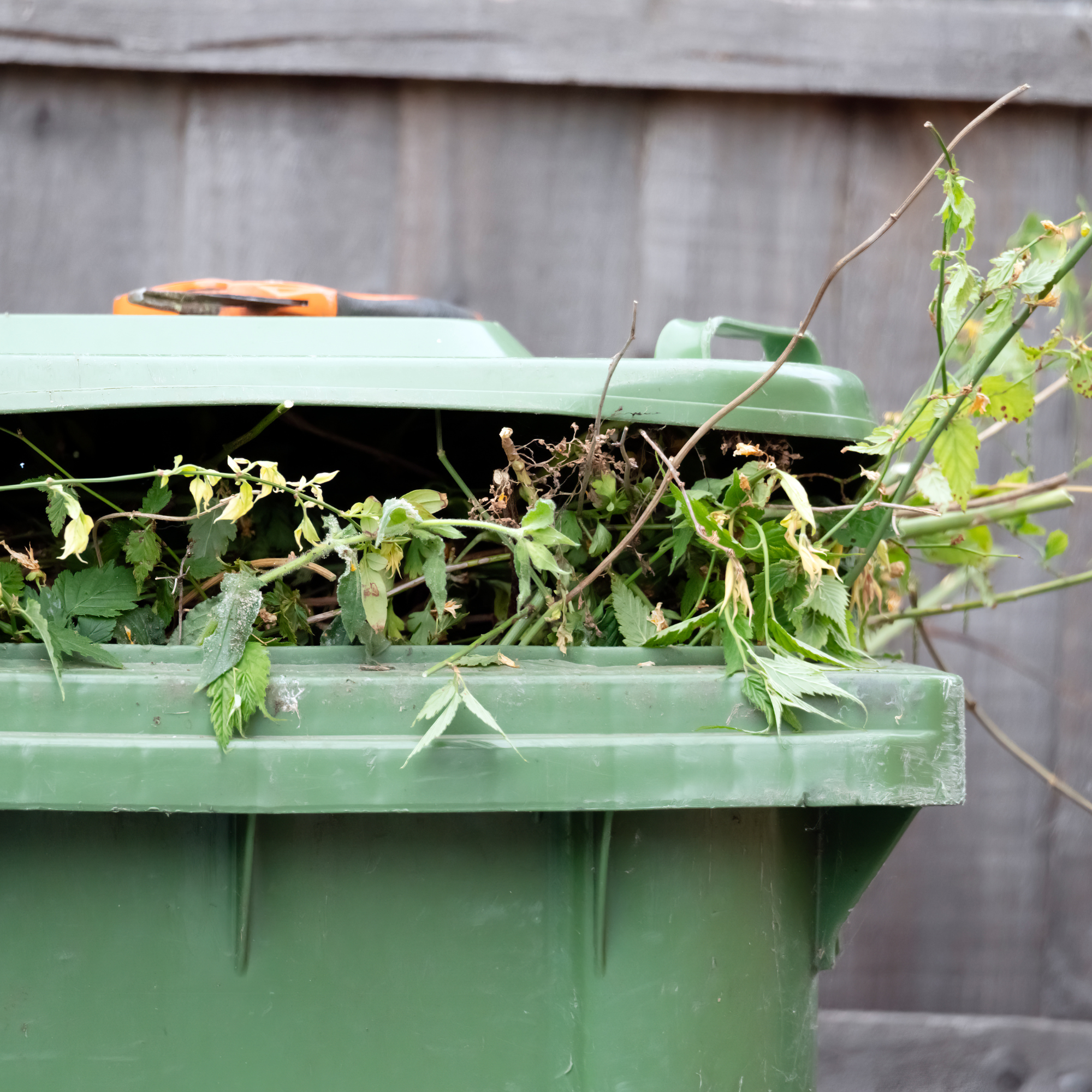 5 things you should never put in your garden waste bin – experts warn these items could land you with a £400 fine
5 things you should never put in your garden waste bin – experts warn these items could land you with a £400 fineYou should avoid these waste items at all costs
By Kezia Reynolds
-
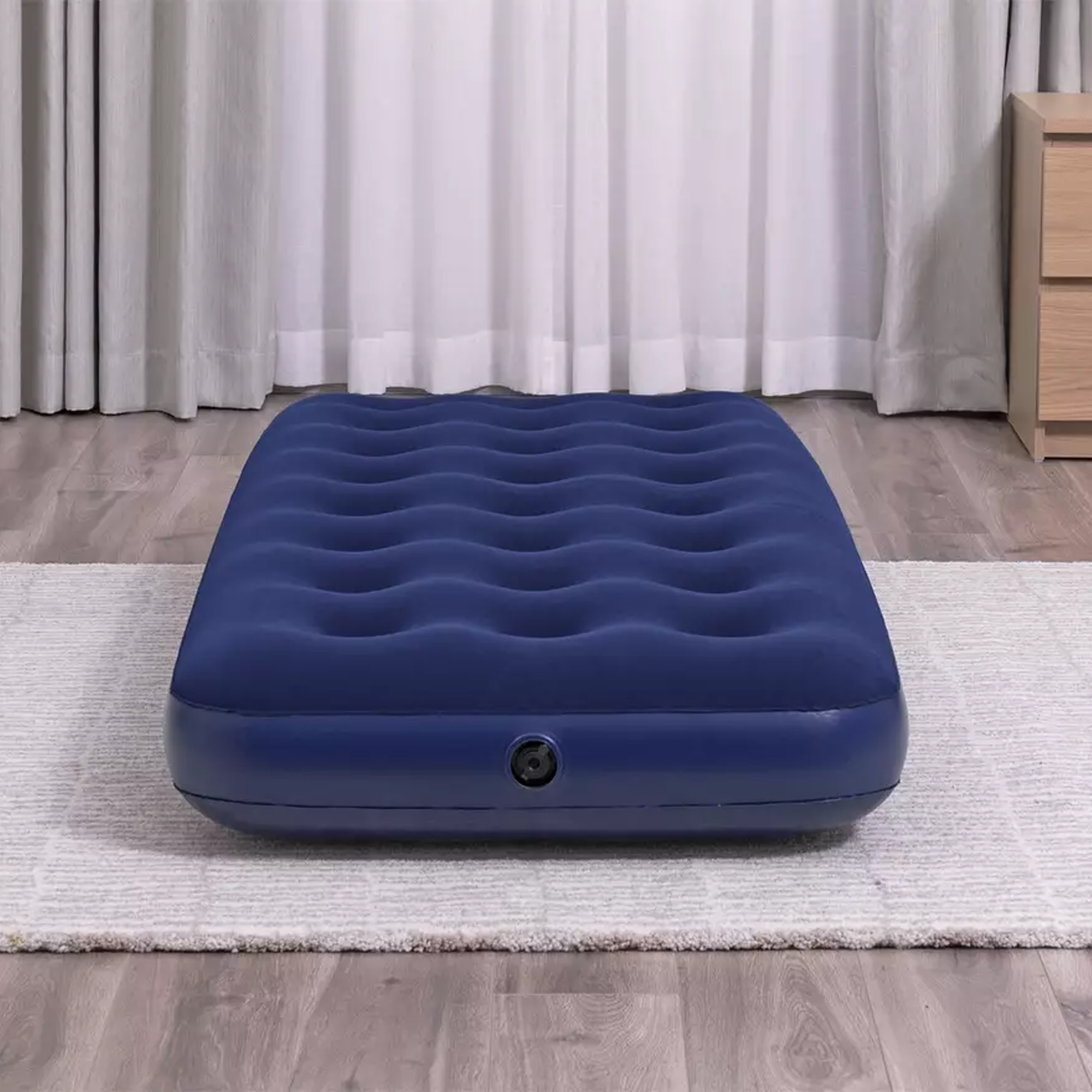 Argos is now selling an air bed for under £12 – if you're hosting guests this Easter Bank Holiday weekend, you'll want this sale on your radar
Argos is now selling an air bed for under £12 – if you're hosting guests this Easter Bank Holiday weekend, you'll want this sale on your radarThis 25% off sale is perfectly timed ahead of Easter weekend
By Amy Lockwood